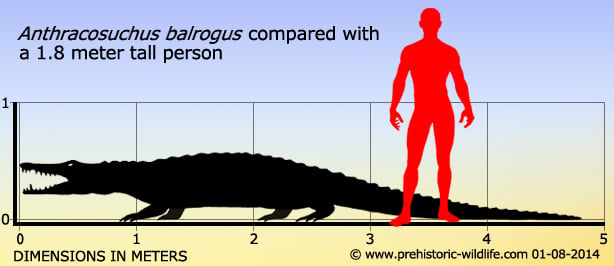In Depth
Anthracosuchus is a genus of dryosaurid crocodile that lived in Colombia approximately sixty million years ago. Unusually for a dryosaurid crocodile, Anthracosuchus had a particularly broad and short blunt snout, very difference to the more slender snouts that are more commonly seen in related genera. A shorter and broader snout indicates that Anthracosuchus likely had a much stronger bite than other dryosaurids since there is more space for stronger and more powerful jaw closing muscles, and food being placed nearer to the point of jaw articulation can have a proportionately greater amount of force brought against it. This in turn suggests that Anthracosuchus may have had a specialist prey preference towards tougher animals such as turtles. Indeed, the turtle genera Carbonemys and Puentemys are known from the same formation as Anthracosuchus, though with adults of these genera having shells over one and a half meters long, Anthracosuchus may have picked on the smaller juveniles of these large turtles.
Anthracosuchus is considered to have been a basal dryosaurid, though it is not the only one from the Paleocene of Colombia, with Chenanisuchus and Cerrejonisuchus also known. The latter of these, Cerrejonisuchus is also known from the same formation as Anthracosuchus, as well as another dryosaurid crocodile genus named Acherontisuchus. With an estimated length of just under five meters, Anthracosuchus would have been at least double the size of the largest estimate for Cerrejonisuchus, but comparable to the lower estimate of Acherontisuchus. If Anthracosuchus had a preference for tough prey like turtles, then this might explain why so many genera of crocodiles were in the same ecosystem; with each genus upholding a particular predatory niche, they could avoid direct competition with one another for the same prey.
The species name for Anthracosuchus, A. barlogus may sound familiar to you. If so then this is because the type species for Anthracosuchus was named after the Balrog, the huge fiery creature that appeared in the Mines of Moria of the first Lord of the Rings book (and later film). A real life monster that Anthracosuchus would have lived in fear of though was the giant snake Titanoboa. With upper estimates ranging between just under thirteen to fifteen meters long, an Anthracosuchus would have been easy prey for a large Titanoboa.
Further Reading
- A new blunt-snouted dyrosaurid, Anthracosuchus balrogus gen. et sp. nov. (Crocodylomorpha, Mesoeucrocodylia), from the Palaeocene of Colombia. - Historical Biology. - A. K. Hastings, J. I. Bloch & C. A. Jaramillo - 2014.










